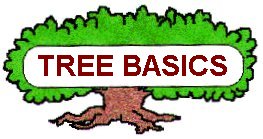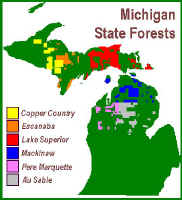

MICHIGAN FORESTS FOREVER TEACHERS GUIDE
| MICHIGAN'S STATE FOREST SYSTEM |
 |
Michigan's forest dominated the landscape for centuries. In the 1800s, settlement, farming, logging, and forest fires changed the landscape dramatically. Farming mostly failed on the poor sandy soils of northern Michigan and logging removed forest cover. Whatever the reason, the landscape was left with dead wood or slash and vulnerable to intense forest fires. In 1871, fires burned approximately 2.5 million acres. Over 1 million acres burned in the Thumb in 1881. Fires destroyed trees, habitat, killed wildlife, and accelerated erosion and river/stream degradation.
In 1887, the State of Michigan established a Forestry Commission to preserve,
protect, and restore Michigan's forests. The Commission was later
dissolved. In 1889, the Forestry Commission was re-established. The
Forestry Commission started nurseries for seedlings and stressed that fire
protection was imperative to good forest management. In 1902, Michigan
Agricultural College (now Michigan State University) established a Forestry
curriculum for education, training, and research. The University of
Michigan (1902) and Michigan Technological University (1936) established
programs as well.
In 1903, the Forestry Commission established the first state forest in Crawford and Roscommon counties. Over the next 100 years the state forest system grew from 34,000 acres to nearly 4 million acres. The vegetation changed dramatically as well, transforming from cutover and burned-over abandoned land to a vibrant, healthy, growing forest.
Today, Michigan's landscape is again dominated by forests, covering a little over half the State. These 19.3 million acres of forest land support a diversity of ecosystems, trees, animals, birds, fish, provide outdoor recreation, protect air and water quality, support local communities and forest industry, and enhance the quality of life in Michigan.
For more information, click here.
 |
This website was developed and created by Michigan State University Extension for the teachers of the State of Michigan. |